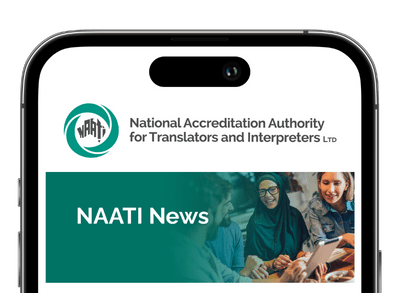NAATI is the only standards body which certifies translators and interpreters to support Australia and New Zealand’s multicultural societies. NAATI certifies practitioners in more than 65 languages across six different test types validating the variety of skills needed to work professionally as an interpreter and translator. There are currently more than 9,000 NAATI certified practitioners across more than 170 languages who support NAATI in realising its vision of a connected community without language barriers.
Over the years, NAATI, like others in the translating and interpreting sector, has witnessed the technological changes impacting the profession including the introduction of computer-assisted tools, improvements in machine translation and more recently the advent of AI. It is therefore instrumental for NAATI to keep abreast of changes to ensure tests remain relevant to the current needs of the market and that practitioners can be supported adequately. NAATI commissioned research to Macquarie University on Translation and Interpreting Technologies and their Impact on the Industry in 2023, which provided useful insights on the ever-evolving translation and interpreting technologies, and recommendations on NAATI certification and practitioner support.
NAATI certifies human translators and interpreters who play an instrumental role in intercultural communication and in supporting multicultural societies. However, NAATI also acknowledges that new technologies like AI have become part of the certified translators’ and interpreters’ toolkit. NAATI believes that human translators and interpreters should remain at the core of intercultural communication and that AI should not be used in high-risk assignments without the expert supervision of a certified practitioner.
Benefits of AI
Free AI bots like ChatGPT are popular because of their interactivity and the speed at which they can respond to prompts. Their versatility also makes them a powerful assistant. They can summarise, translate, write, provide information in response to a question and assist with workflow efficiencies. In the work of a translator, they can support the creation of terminology lists, assignment preparation, provide a draft translation and support translation workflows. Machine interpretation produced by AI software facilitates real-time multilingual communication without human input. In the work of an interpreter, machine interpretation software can support the creation of terminology lists, assignment preparation, provide transcriptions and live captions, and assist interpreters in checking a glossary term or capturing complex figures.
With the use of AI, the “augmented” translator or interpreter can have access to a broad range of tools that they can decide to use to support their work and increase their productivity.
Risks associated with the unsupervised use of AI
The unsupervised use of AI can present a high level of risk in situations where translation or interpreting errors can have severe consequences on the individual(s) the translation or the interpretation is for. For instance, using AI to translate aircraft safety specifications without involving a qualified translator specialising in aeronautics, or relying on AI to translate a list of ingredients for someone with allergies, can have serious consequences. Not involving a human may result in an undesired outcome and the perceived cost saving may result in more liabilities. Additionally, free AI tools do not guarantee the accuracy or appropriateness of the translated content nor the security of the input data. They do not bear the risk for the end-user. The input data will be used to train and improve the AI model.
In the translation context, Large Language Models (LLMs) provide a fluent output in many languages. They are trained on a large corpus of data and function by predicting the next word based on the previous words in a sentence. They do not “understand” nor are they “intelligent” in the way human intelligence is generally understood. They are only as good as the data they are trained on. As a result, they sometimes provide inaccurate and misleading responses, including what is commonly referred to as “hallucinations”, and biased content that may not represent the end-user’s views. If used without understanding both languages, the translation they provide may seem accurate – however, this may not be the case. In some languages where the volume of data is lesser, the translation may be nonsensical or of poor quality.
In interpreting contexts, AI interpreting tools cannot learn from the context of the conversation. For instance, they will not be able to identify the need to self-correct or reformulate key information where required, nor will they be able to identify cultural nuances that are essential to a successful interaction, which could lead to misunderstandings and undesired outcomes.
The role of the human practitioner
To become NAATI-certified, practitioners must meet training prerequisites and demonstrate ethical and intercultural competency. They are bound by a code of ethics such as the AUSIT, NZSTI or ASLITA codes of ethics. As such, practitioners have an ethical obligation to undertake work they are qualified for and ensure confidentiality.
NAATI-certified practitioners have demonstrated that they have the skills to practice as a translator or an interpreter. They are required to engage in professional development to maintain the technical skills to do their work. They can sometimes offer expertise in one or several domains and can play a role in managing the risk associated with the accuracy of AI translated or interpreted content.
In the age of AI, human practitioners can also help clients navigate their translation and interpreting needs by providing advice on the type of tool that is suitable for their project. Depending on the content type, AI may be suitable with human review; in other contexts, the risk level or confidentiality implications may mean that a human translation or interpreting is required.
As a result, human practitioners have become, more than ever, risk managers who can help clients review their content for unintended consequences, tailor it to a specific audience, and guide them in the complex landscape of translation and interpreting technologies.
Additional resources
- SAFE-AI Guidance
- Translator and interpreter codes of ethics: AUSIT | ASLITA | NZSTI
- Machine Translation Literacy – Teaching Resources

